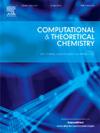裸和oh功能化co - n掺杂芘对ORR和HER的电催化电位:DFT研究
IF 3
3区 化学
Q3 CHEMISTRY, PHYSICAL
引用次数: 0
摘要
开发用于氧还原反应(ORR)和析氢反应(HER)的高效双功能电催化剂对于燃料电池和水分解过程等再生应用至关重要。单原子催化剂(SACs)在ORR和HER机制中具有成本低、选择性高、催化性能优异等优点。本研究利用密度泛函理论(DFT)计算研究了钴和氮掺杂芘(Co-N-PYR)和羟基功能化钴和氮掺杂芘(Co-N-PYR(OH)10)表面的催化活性。热化学性质表明,Co-N-PYR和Co-N-PYR(OH)10表面的ORR机制是高度放热和能量有利的。在Co-N-PYR和Co-N-PYR(OH)10表面上,ORR的总自由能变化表明是自发反应。对于HER, Co-N-PYR(OH)10对氢的吸附自由能(ΔGH*)为‐0.03 eV,接近理想催化剂(ΔGH*≈0),预测Co-N-PYR(OH)10的ORR和HER过电位分别为0.88 V和‐0.03 V。这些结果表明,Co-N-PYR(OH)10是ORR和HER工艺的优良双功能电催化剂。本文章由计算机程序翻译,如有差异,请以英文原文为准。

Electrocatalytic potential of bare and OH-functionalized Co-N-doped pyrene for ORR and HER: A DFT study
Developing efficient bifunctional electrocatalysts for the oxygen reduction reaction (ORR) and hydrogen evolution reaction (HER) is essential for regenerative applications such as fuel cells and water-splitting processes. Single-atom catalysts (SACs) offer advantages of low cost, high selectivity, and excellent catalytic performance in ORR and HER mechanisms. This study investigates the catalytic activity of cobalt and nitrogen-doped pyrene (Co-N-PYR) and hydroxyl-functionalized cobalt and nitrogen-doped pyrene (Co-N-PYR(OH)10) surfaces using density functional theory (DFT) calculations. The thermochemical properties reveal that ORR mechanisms on Co-N-PYR and Co-N-PYR(OH)10 surfaces are highly exothermic and energetically favorable. The overall free energy changes for ORR on Co-N-PYR and Co-N-PYR(OH)10 surfaces indicate spontaneous reactions. For HER, the free energy of hydrogen adsorption (ΔGH*) on Co-N-PYR(OH)10 is ‐0.03 eV, close to the ideal catalyst (ΔGH*≈ 0). The predicted ORR and HER overpotentials for Co-N-PYR(OH)10 are 0.88 V and ‐0.03 V, respectively. These results demonstrate that Co-N-PYR(OH)10 is an excellent bifunctional electrocatalyst for ORR and HER processes.
求助全文
通过发布文献求助,成功后即可免费获取论文全文。
去求助
来源期刊

Computational and Theoretical Chemistry
CHEMISTRY, PHYSICAL-
CiteScore
4.20
自引率
10.70%
发文量
331
审稿时长
31 days
期刊介绍:
Computational and Theoretical Chemistry publishes high quality, original reports of significance in computational and theoretical chemistry including those that deal with problems of structure, properties, energetics, weak interactions, reaction mechanisms, catalysis, and reaction rates involving atoms, molecules, clusters, surfaces, and bulk matter.
 求助内容:
求助内容: 应助结果提醒方式:
应助结果提醒方式:


